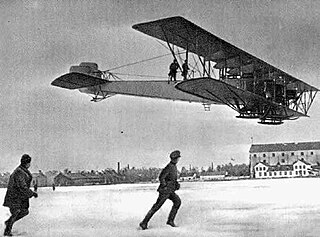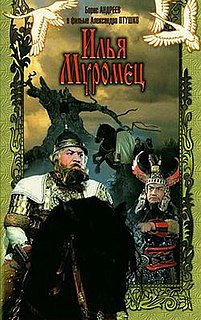Places
- Ilya Muromets Waterfall, a waterfall on Iturup, one of the Kuril Islands
Ilya Muromets is an epic hero of Russian folklore
Ilya Muromets may also refer to:

Reinhold Moritzevich Glière, was a Russian and Soviet composer of Ukrainian, German and Polish descent. In 1938, he was awarded the title of People's Artist of the USSR.

Ilya Muromets, or Ilya of Murom, sometimes Ilya Murometz, is one of the bogatyrs in Bylinas of Kievan Rus. He is often featured alongside fellow bogatyrs Dobrynya Nikitich and Alyosha Popovich.
Ilya, Illia, Illya, Iliya, Il'ja, Ilija, or Ilia is the East Slavic form of the male Hebrew name Eliyahu (Elijah), meaning "My God is Yahu/Jah." It comes from the Byzantine Greek pronunciation of the vocative (Ilía) of the Greek Elias. It is pronounced with stress on the second syllable. The diminutive form is Iliusha or Iliushen'ka. The Russian patronymic for a son of Ilya is "Il'jich", and a daughter is "Ilyinichna".

Aleksandr Lukich Ptushko was a Soviet animation and fantasy film director, and a People's Artist of the USSR (1969). Ptushko is frequently referred to as "the Soviet Walt Disney," due to his prominent early role in animation in the Soviet Union, though a more accurate comparison would be to Willis O'Brien or Ray Harryhausen. Some critics, such as Tim Lucas and Alan Upchurch, have also compared Ptushko to Italian filmmaker Mario Bava, who made fantasy and horror films with similarities to Ptushko's work and made similarly innovative use of color cinematography and special effects. He began his film career as a director and animator of stop-motion short films, and became a director of feature-length films combining live-action, stop-motion, creative special effects, and Russian mythology. Along the way he would be responsible for a number of firsts in Russian film history, and would make several extremely popular and internationally praised films full of visual flair and spectacle.

The Sikorsky Ilya Muromets were a class of Russian pre-World War I large four-engine commercial airliners and military heavy bombers used during World War I by the Russian Empire. The aircraft series was named after Ilya Muromets, a hero from Slavic mythology. The series was based on the Russky Vityaz or Le Grand, the world's first four-engined aircraft, designed by Igor Sikorsky. The Ilya Muromets aircraft as it appeared in 1913 was a revolutionary design, intended for commercial service with its spacious fuselage incorporating a passenger saloon and washroom on board. The Ilya Muromets was the world's first multi-engine aircraft in production and at least sixty were built. During World War I, it became the first four-engine bomber to equip a dedicated strategic bombing unit. This heavy bomber was unrivaled in the early stages of the war, as the Central Powers had no aircraft capable enough to rival it until much later.

Nightingale the Robber or Solovei the Brigand, an epic robber, appears in traditional Russian byliny.

Svyatogor is a mythical bogatyr (knight/hero) in ancient bylinas of Kievan Rus. His name derives from the words for "sacred mountain". Svyatogor's tale, Ilya Muromets and Svyatogor, forms a part of the Ilya Muromets cycle. According to the epic, the mother-Earth cannot support the weight of Svyatogor, but he can not overcome the "pull of the earth" contained in the bag: when he tries to lift the bag, his feet sink into the ground. Svyatogor's father is "dark", he is blind - a sign of coming from another world.

A bogatyr or vityaz is a stock character in medieval East Slavic legends, akin to a Western European knight-errant. Bogatyrs appear mainly in Rus' epic poems—bylinas. Historically, they came into existence during the reign of Vladimir the Great as part of his elite warriors (druzhina), akin to Knights of the Round Table. Tradition describes bogatyrs as warriors of immense strength, courage and bravery, rarely using magic while fighting enemies in order to maintain the "loosely based on historical fact" aspect of bylinas. They are characterized as having resounding voices, with patriotic and religious pursuits, defending Rus' from foreign enemies and their religion. In modern Russian, the word bogatyr labels a courageous hero, an athlete or a physically strong man.

Dobrynya Nikitich is one of the most popular bogatyrs from the Rus' folklore. Albeit fictional, this character is based on a real warlord Dobrynya, who led the armies of Svyatoslav the Great and tutored his son Vladimir the Great.

Ilya Muromets, known in the US as The Sword and the Dragon and in the UK as both The Epic Hero and the Beast and The Sword and The Dragon, is a Soviet fantasy film directed by the noted fantasy director Aleksandr Ptushko, made at Mosfilm and released in 1956. It is based on the old Russian oral epic poems about the knight Ilya Muromets.

Demon is a stratovolcano located at the northern end of Iturup/Etorofu Island, Chishima Islands, Hokkaido, Japan.
Iya Alexeyevna Arepina was a Soviet/Russian actress.
The Three Bogatyrs is an animated franchise produced by Melnitsa Animation Studio. Voices of Sergey Makovetsky, Dmitry Vysotsky, Liya Medvedeva, Valery Soloviev, Oleg Kulikovich, Oleg Tabakov, Anatoly Petrov, Andrei Tolubeyev and Fyodor Bondarchuk with Elizaveta Boyarskaya are featured in the films. The overall plot through the series follows the adventures of three most famous bogatyrs: Alyosha Popovich, Dobrynya Nikitich and Ilya Muromets.
Idolishche Poganoye is a mythological monstrosity from Russian bylinas and other folklore; he personifies pagan forces invading the Russian lands. The name literally means "pagan idol", with a Russian augmentative suffix "-ishche".

Ilya Muromets, named after the East Slavic folk hero, is a very steep vertical waterfall on the Bear's Peninsula of Iturup, one of the Kuril Islands. The water stream falls abruptly from the eastern slope of the Demon Volcano into the Pacific Ocean. With a height of 141 meters, it is one of the highest waterfalls in the Russian Far East. Ilya Muromets is rarely seen by tourists, however, because it can be accessed only by boat.

Ilya Muromets, Russian designation Project 21180, is a Russian icebreaker built by Admiralty Shipyard in Saint Petersburg and commissioned on 30 November 2017. She is the first icebreaker built for the Russian Navy in almost 40 years.
Vympel Design Bureau is a Russian ship design company based in Nizhny Novgorod.

Eisbär was a steam-powered Kriegsmarine port icebreaker built at Eriksbergs Mekaniska Verkstad in Göteborg, Sweden, in 1942. She had two triple-expansion steam engines driving one propeller in the stern and another in the bow of the vessel.
A number of icebreakers have been named Ilya Muromets after the Russian folk hero:

Eisvogel was an icebreaker in the Kriegsmarine during World War II. After the war, the ship served in the Soviet Union until 1972.